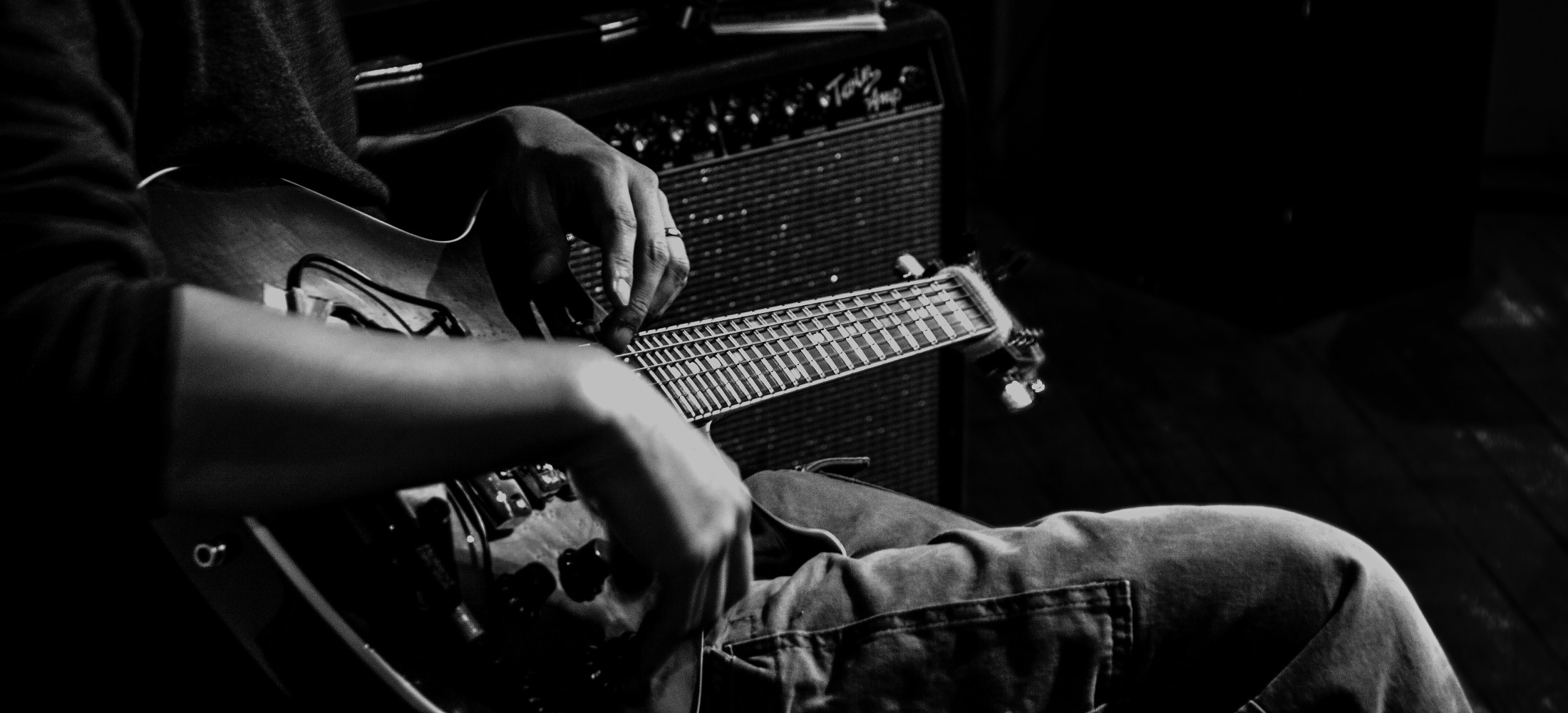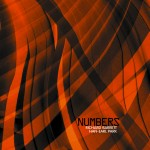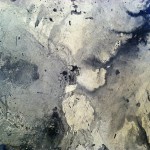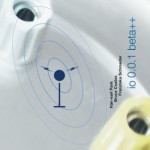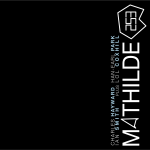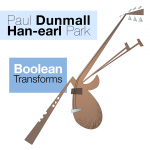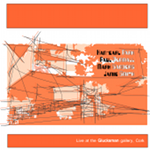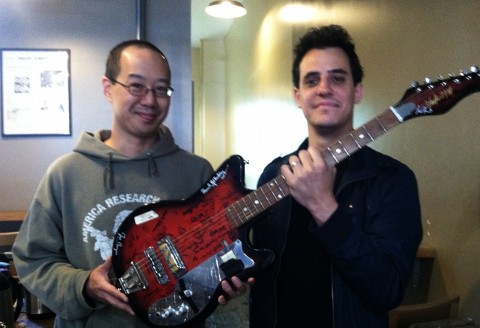
After recording my sixty-seven second ditty for the $100 Guitar Project, the instrument gets handed over to Taylor Levine. [About my track…] [more about this project…]
recording: $100 Guitar Project
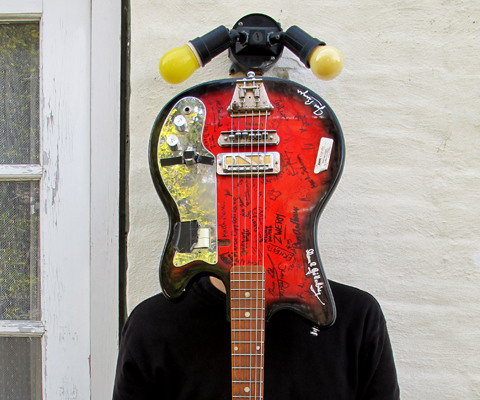
Today, for the $100 Guitar Project, I recorded a sixty-seven second track with the title
apophenia: A atomic symphony in 10 movements
ii you seek
iii a comfortable spot to listen
iv to this
v track the sofa perhaps
vi or the
vii floor however
viii standing hand
ix suspended over the volume
x control you
xi find that
xii it is
“Charmed by its [the $100 guitar’s] no-name vibe and single bridge pickup that looks like an old radio,” Nick Didkovsky and Chuck O’Meara masterminded the $100 Guitar Project which now involves some 68+ guitarists. Bridge Records will release the project as a double CD with royalties to go to CARE. [More about this project…]
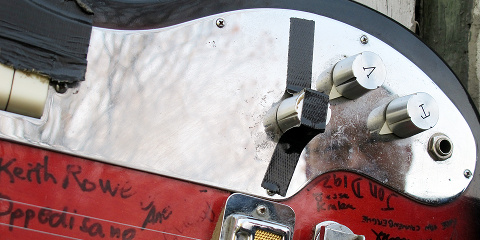
Big thanks to Scott Friedlander for the recording and the photography, and thanks to Nick and Chuck for the invitation to join this project.
audio review: Catherine Sikora, Ian Smith and Han-earl Park (Cork, 04–04–11)
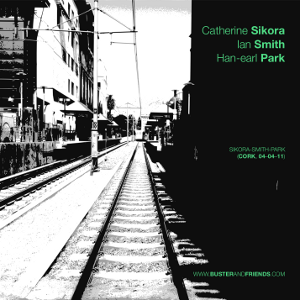
Distant mountain ranges, plateaus and landscapes populate Dave Sumner’s review at Bird is the Worm of the download release by Catherine Sikora, Ian Smith and Han-earl Park:
Han-earl Park has a special place in my music experience. I think, without exception, there has not yet been an opening to any one of his compositions where I have not had an adverse reaction, either repelling me back in my seat or leaving me shaking my head in exasperation of the noise coming out of my speakers. But the thing of it is, without exception, I find myself listening straight through to the final note. Somehow Han-earl Park finds a way to convert my ears to his music one song at a time….
There is no other artist in which I describe this way….
‘Topologically Correct Harry,’ it’s Sikora’s sax that ushers the listener right on in through the front door. Utilizing a pattern of phrasing that gives the impression of outlining a mountain range from a distance, Sikora’s sax is at the center of attention, with Smith’s trumpet searing blemishes of heat on a radar screen as Park’s guitar gurgles and pops just beneath the surface….
‘바르트’ has Ian Smith’s trumpet setting the table and drawing up a spontaneous menu of jab-right-cross combinations. Sikora moves in slow, but once she’s got both feet in the room, her sound expands into wildly arcing phrases that, when combined with Smith’s one-twos, makes for a delicious whirling dervish of sound. Park mostly keeps to the background, picking his spots and letting things develop organically….
‘Red Line Speed’ begins as a slow build that gains momentum along with height. It hits a plateau at the heart of the song, giving the sense of all three instruments feeling around in the dark to figure out the lay of the land before continuing their ascent in the final stretch of the track….
‘Massimo’s Imagined Juxtapositions’ is a lonely streetlight on a deserted midnight avenue, and the instruments are the moths darting in and out of the dim light carved into the darkness.
[Read the rest…] [More about this recording…] [All reviews…]
Also available for download…
audio recordings: Paul Dunmall, Han-earl Park and Mark Sanders (Birmingham, 02–15–11)
audio recordings: Han-earl Park and Richard Scott (Berlin, 10–23–10)
audio recordings: Han-earl Park plus Marian Murray (Cork, 07–29–10)
audio recordings: Han-earl Park and Franziska Schroeder (Cork, 03–26–09)
audio recordings: Catherine Sikora, Ian Smith and Han-earl Park (Cork, 04–04–11)

The complete recording of the April 4, 2011 performance by Catherine Sikora (saxophone), Ian Smith (trumpet) and Han-earl Park (guitar) is now available for download. (Special mention to drummer, composer and electronic artist Jeffrey Weeter who couldn’t make the gig, but who, perhaps, is there in the recordings in spirit.) [Bandcamp page…] [Download now…]
Recommended price: €8+
Unlike previous download releases from busterandfriends.com, this one is hosted at Bandcamp, and available as a ‘name your price’ album. Although you can download the recording for free (name €0 as your price) with certain restrictions, please consider paying at least the recommended price. Your generosity will help support the performers and their work. (Many thanks to Alex Fiennes, Corey Mwamba and Anton Hunter for Bandcamp specific advice and support.)
description
A wonderful gem of a recording.
— Philip Coombs (Free Jazz)
There is a new surprise around nearly every corner throughout this often fascinating performance.
— Tom Burris (Free Jazz)
This album rocks.
— Dave Sumner (Bird is the Worm)
A one-of-a-kind improvised musical meeting between artists from Ireland based overseas, and a then Ireland-based artist from abroad which took place on April 4, 2011 at The Roundy, Cork, Ireland.
This was a rare performance in Ireland by Catherine Sikora (New York-based, originally from West Cork), a saxophonist with a striking, compelling sound. She has been described as “a free-blowing player’s player with a spectacular harmonic imagination and an evolved understanding of the tonal palette of the saxophone” (Chris Elliot, Seacoast Online). Sikora was joined by cofounder of the London Improvisers’ Orchestra, trumpeter Ian Smith (London-based, from Dublin), and guitarist Han-earl Park (then Cork-based, currently Brooklyn-based, from California). Smith and Park had just come off the tour as part of the power-trio Mathilde 253 (with Charles Hayward) with the legendary composer-improviser Ishmael Wadada Leo Smith.
personnel
Catherine Sikora (saxophone), Ian Smith (trumpet) and Han-earl Park (guitar).
track listing
Topologically Correct Harry (16:10), 바르트 (8:03), Red Line Speed (24:20), Massimo’s Imagined Juxtapositions (11:40). Total duration: 60:13.
recording details
All music by Catherine Sikora, Ian Smith and Han-earl Park
Recorded live April 4, 2011 at The Roundy, Cork.
Recorded and mixed by Han-earl Park.
Artwork by Han-earl Park.
The recordings (Topologically Correct Harry, 바르트, Red Line Speed, and Massimo’s Imagined Juxtapositions) and artwork released under a Creative Commons Attribution-Noncommercial-No Derivative Works 3.0 Unported License. Please attribute the recordings to Catherine Sikora, Ian Smith and Han-earl Park, and attribute the artwork to Han-earl Park.
about the performers
Since making her way to New York City from West Cork, Ireland to study abstract improvisation, Catherine Sikora has become a well-known face and sound in New York creative music circles. She has worked with Elliott Sharp, Eric Mingus, Michael Evans, Matt Lavelle, Jeremy Bacon, François Grillot and Burnt Sugar The Arkestra Chamber, among many others. Her undeniably unique approach sets her apart from everyone else, even when surrounded by the most original and creative voices in New York City. Sikora is a contributing writer to the book “Silent Solos-Improvisers Speak” (Buddy’s Knife Publishing, Köln, DE) and is currently working on producing a solo recording.
Ian Smith has performed with Evan Parker, John Stevens, Maggie Nicols, Lol Coxhill, Steve Beresford, Eddie Prévost, Greg Tate’s Burnt Sugar Arkestra, Reeves Gabrels, John Sinclair, Harris Eisenstadt and many others. In 2000 he recorded his second CD as a leader, Daybreak, with Derek Bailey, Veryan Weston, Gail Brand and Oren Marshall. His own trio, Trian, has played the London Experimental Music Festival and the Soho Jazz Festival. He also participated in a reformation of Cornelius Cardew’s Scratch Orchestra in 1994. He has collaborated with composer Roger Doyle, winner of the Bourges International Elecro-Acoustic Music Competition, and he has been featured on two instrumental tracks by the hip hop band Marxman. He toured the UK with Butch Morris’ London Skyscraper conduction project. He cofounded the London Improvisers’ Orchestra and The Gathering.
Improviser, guitarist and constructor Han-earl Park works within/from/around traditions of fuzzily idiomatic, on occasion experimental, mostly open improvised musics, sometimes engineering theater, sometimes inventing ritual. He feels the gravitational pull of collaborative, multi-authored contexts, and has performed in clubs, theaters, art galleries and concert halls in Austria, Denmark, Germany, England, Ireland, The Netherlands, Scotland and the USA. He is part of Mathilde 253 with Charles Hayward and Ian Smith, and is involved in ongoing collaborations with Bruce Coates, Franziska Schroeder, Alex Fiennes and Murray Campbell. He has recently performed with Ishmael Wadada Leo Smith, Lol Coxhill, Pat Thomas, Paul Dunmall, Mark Sanders, Matana Roberts, Richard Barrett, Pauline Oliveros, Thomas Buckner and Kato Hideki. Festival appearances include Sonorities (Belfast), Sonic Acts (Amsterdam), dialogues festival (Edinburgh), and CEAIT Festival (California). His recordings have been released by labels including Slam Productions and DUNS Limited Edition.
Also by Han-earl Park and Catherine Sikora
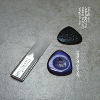
Anomic Aphasia (SLAMCD 559) [details…]
Performers: Han-earl Park (guitar), Catherine Sikora (tenor and soprano saxophones), Nick Didkovsky (guitar), and Josh Sinton (baritone saxophone and bass clarinet).
© 2015 Han-earl Park.
℗ 2015 SLAM Productions.
Also by Han-earl Park and Ian Smith
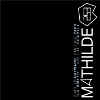
Mathilde 253 (SLAMCD 528) [details…]
Performers: Charles Hayward (drums, percussion and melodica), Han-earl Park (guitar) and Ian Smith (trumpet and flugelhorn) plus Lol Coxhill (saxophone).
© 2010 Han-earl Park.
℗ 2010 SLAM Productions.
Also available for download [more…]
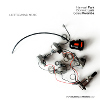
A Little Brittle Music [details…]
Performers: Han-earl Park (guitar), Dominic Lash (double bass) and Corey Mwamba (vibraphone and flute).
© 2015 Han-earl Park. ℗ 2015 Park/Lash/Mwamba.
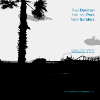
Dunmall-Park-Sanders (Birmingham, 02-15-11) [details…]
Performers: Paul Dunmall (saxophones and bagpipes), Han-earl Park (guitar) and Mark Sanders (drums).
(cc) 2013 Paul Dunmall/Han-earl Park/Mark Sanders.
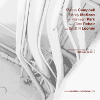
Gargantius Effect +1 +2 +3 (Nor Cal, 08-2011) [details…]
Performers: Murray Campbell (violins, oboe and cor anglais), Randy McKean (saxophone, clarinets and flutes) with Han-earl Park (guitar), plus Gino Robair (energized surfaces, voltage made audible) and Scott R. Looney (hyperpiano).
(cc) 2012 Murray Campbell/Randy McKean/Han-earl Park/Gino Robair/Scott R. Looney.
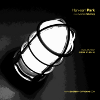
Park+Murray (Cork, 07-29-10) [details…]
Performers: Han-earl Park (guitar) plus Marian Murray (violin).
(cc) 2012 Han-earl Park/Marian Murray.

Jin-Park-Weeter (Cork, 01-24-11) [details…]
Performers: Jin Sangtae (electronics), Han-earl Park (guitar) and Jeffrey Weeter (drums and electronics).
(cc) 2012 Jin Sangtae/Han-earl Park/Jeffrey Weeter.
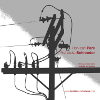
Park-Schroeder (Cork, 03-26-09) [details…]
Performers: Han-earl Park (guitar) and Franziska Schroeder (saxophone).
(cc) 2012 Han-earl Park/Franziska Schroeder.
updates

Anomic Aphasia (SLAMCD 559) [details…]
Performers: Han-earl Park (guitar), Catherine Sikora (tenor and soprano saxophones), Nick Didkovsky (guitar), and Josh Sinton (baritone saxophone and bass clarinet).
© 2015 Han-earl Park.
℗ 2015 SLAM Productions.

Mathilde 253 (SLAMCD 528) [details…]
Performers: Charles Hayward (drums, percussion and melodica), Han-earl Park (guitar) and Ian Smith (trumpet and flugelhorn) plus Lol Coxhill (saxophone).
© 2010 Han-earl Park.
℗ 2010 SLAM Productions.

A Little Brittle Music [details…]
Performers: Han-earl Park (guitar), Dominic Lash (double bass) and Corey Mwamba (vibraphone and flute).
© 2015 Han-earl Park. ℗ 2015 Park/Lash/Mwamba.

Dunmall-Park-Sanders (Birmingham, 02-15-11) [details…]
Performers: Paul Dunmall (saxophones and bagpipes), Han-earl Park (guitar) and Mark Sanders (drums).
(cc) 2013 Paul Dunmall/Han-earl Park/Mark Sanders.

Gargantius Effect +1 +2 +3 (Nor Cal, 08-2011) [details…]
Performers: Murray Campbell (violins, oboe and cor anglais), Randy McKean (saxophone, clarinets and flutes) with Han-earl Park (guitar), plus Gino Robair (energized surfaces, voltage made audible) and Scott R. Looney (hyperpiano).
(cc) 2012 Murray Campbell/Randy McKean/Han-earl Park/Gino Robair/Scott R. Looney.

Park+Murray (Cork, 07-29-10) [details…]
Performers: Han-earl Park (guitar) plus Marian Murray (violin).
(cc) 2012 Han-earl Park/Marian Murray.

Jin-Park-Weeter (Cork, 01-24-11) [details…]
Performers: Jin Sangtae (electronics), Han-earl Park (guitar) and Jeffrey Weeter (drums and electronics).
(cc) 2012 Jin Sangtae/Han-earl Park/Jeffrey Weeter.

Park-Schroeder (Cork, 03-26-09) [details…]
Performers: Han-earl Park (guitar) and Franziska Schroeder (saxophone).
(cc) 2012 Han-earl Park/Franziska Schroeder.
10-24-12: add recommended price and SLAMCD 528 info.
05-20-13: updated the ‘also available for download’ list, and add reviews.
10-07-15: add ‘Anomic Aphasia’ to discography.
11-01-15: add A Little Brittle Music to downloads list, and change currency from USD to EUR.
in preparation: Catherine Sikora, Ian Smith and Han-earl Park (Cork, 04–04–11)

Next download release from busterandfriends.com will be the recording of the April 4, 2011 performance by Catherine Sikora (saxophone), Ian Smith (trumpet) and Han-earl Park (guitar).
Unlike previous download releases, this one will be hosted at Bandcamp, and available as a ‘name your price’ album. You will still be able to download the release for free (name $0 as your price), but any payment will help support the performers and their work.
More info to follow…
Still available…
audio recordings: Paul Dunmall, Han-earl Park and Mark Sanders (Birmingham, 02–15–11)
audio recordings: Han-earl Park and Richard Scott (Berlin, 10–23–10)
audio recordings: Han-earl Park plus Marian Murray (Cork, 07–29–10)
audio recordings: Han-earl Park and Franziska Schroeder (Cork, 03–26–09)
CD available: Numbers: Richard Barrett + Han-earl Park
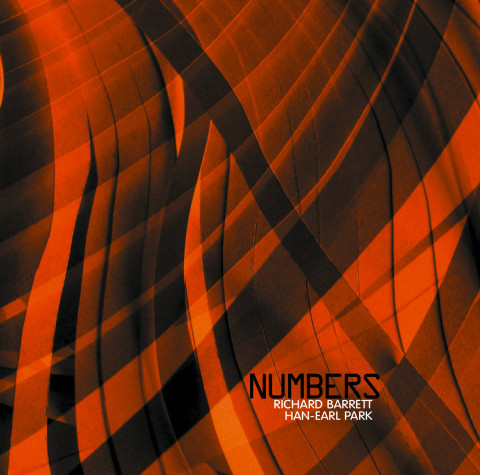
Released as part of Creative Sources Recordings’ February 2012 CD catalog: ‘Numbers’ (CS 201 cd), a duo recording by composer, performer and electronic musician Richard Barrett and guitarist, improviser and constructor Han-earl Park.
[Creative Sources catalog page…]
[Numbers project page…]
[Discography entry…]
description
Lively, relevant, dizzying electroacoustic music; music that seems to be daring us to try and catch it. [More…]
— François Couture (Monsieur Délire)
The fractured phrases that erupt throughout this disc often sound like just one musician playing…. Completely unique, exciting and engaging. [More…]
— Bruce Lee Gallanter (Downtown Music Gallery)
By means of an intricate web of sonic hiccups, scrapes, scouring, gluts, gargles and cuts, they build an acoustic lucid computational delirium, whose trajectory is impossible to outguess. [More…]
— Vito Camarretta (Chain D.L.K.)
Bazillions of events… for the joy of individuals who take pleasure in getting their brain zapped and scrambled by the rivalry between transonic beauty and extreme structural atomization. This is in fact a full hour of frantically jagged live improvisation…. [More…]
— Massimo Ricci (Touching Extremes)
Kaleidoscopic music, a rubato flux of superimposed noises in which lightning-fast progression from one galvanising sound event (noise thru silence) to another, and the musicians’ constant attention to overall form… it’s music of the moment, a process of constantly tweaked evolutionary recombination. [More…]
— Tim Owen (Dalston Sound)
Numbers is a high-energy, quick-footed, scatter-brained two hander—a looping, convoluted, interactive dance made audible—a musical fender bender involving electroacoustic complexities and (physio)logical splutter-cuts, jump-cuts and match-cuts—an intense white-knuckle extemporization unit—the duo of composer, performer and electronic musician Richard Barrett and guitarist, improviser and constructor Han-earl Park.
Celebrated for his dense, complex, intricate music, Richard Barrett is perhaps best known for his work with Paul Obermayer as part of FURT, as part of the Evan Parker Electro-Acoustic Ensemble, and his close collaborations with the Elision Ensemble. At home in both composition and improvisation, Barrett’s music increasingly problematizes the distinction between them. Described by Brian Morton as “a musical philosopher… a delightful shape-shifter”, Han-earl Park is drawn to real-time cyborg configurations in which artifacts and bodies collide. He has performed with some of the finest practitioners of improvised music, and is part of Mathilde 253 with Charles Hayward and Ian Smith. First performing together as duo in at AUXXX, Berlin, October 2010, Barrett and Park engage in a continuing improvisative conversation; alternately claiming autonomy and independence, and group action and solidarity.
Track titles derive from the final section of numbers, an extended poem by Simon Howard, published in 2010 digitally by Mark Cobley and in book form by The Knives Forks And Spoons Press.
audio excerpts
Audio excerpts courtesy of Creative Sources Recordings.
Music by Richard Barrett and Han-earl Park.
Audio ℗ 2012 Creative Sources Recordings. Please do not distribute the audio files.
personnel
Richard Barrett (electronics) and Han-earl Park (guitar).
track listing
tolur (15:38), tricav (10:42), ankpla (10:46), uettet (5:17), creens (6:03), ll……. (11:42). Total duration: 60:00.
recording details
All music by Richard Barrett and Han-earl Park.
Recorded March 10, 2011 at the Institute of Sonology, The Hague.
Recorded by Richard Barrett and Han-earl Park. Mixed by Richard Barrett.
Design and artwork by Carlos Santos.
Produced by Ernesto Rodrigues.
© + ℗ 2012 Creative Sources Recordings.
about the performers
Richard Barrett (www.richardbarrettmusic.com) is internationally active as both composer and improvising performer, and has collaborated with many leading performers in both areas, while developing works and ideas which increasingly leave behind the distinctions between them. His long-term collaborations include the electronic duo FURT which he formed with Paul Obermayer in 1986 (and its more recent octet version fORCH), composing for and performing with the Elision contemporary music group since 1990, and regular appearances with the Evan Parker Electro-Acoustic Ensemble since 2003. Recent projects include “CONSTRUCTION”, a two-hour work for twenty performers and three-dimensional sound system, premiered by Elision in November 2011. He is based in Berlin and currently teaches at the Institute of Sonology in The Hague. His work as composer and performer is documented on over 20 CDs, including five discs devoted to his compositions and seven by FURT.
Improviser, guitarist and constructor Han-earl Park (www.busterandfriends.com) works within/from/around traditions of fuzzily idiomatic, on occasion experimental, mostly open improvised musics, sometimes engineering theater, sometimes inventing ritual. He feels the gravitational pull of collaborative, multi-authored contexts, and has performed in clubs, theaters, art galleries and concert halls in Austria, Denmark, Germany, England, Ireland, The Netherlands, Scotland and the USA.
He is part of Mathilde 253 with Charles Hayward and Ian Smith, and is involved in ongoing collaborations with Bruce Coates, Franziska Schroeder, Alex Fiennes and Murray Campbell. He has recently performed with Ishmael Wadada Leo Smith, Lol Coxhill, Pat Thomas, Paul Dunmall, Mark Sanders, Matana Roberts, Richard Barrett, Pauline Oliveros, Thomas Buckner and Kato Hideki. Festival appearances include Sonorities (Belfast), Sonic Acts (Amsterdam), dialogues festival (Edinburgh), and CEAIT Festival (California). His recordings have been released by labels including Slam Productions and DUNS Limited Edition.
also by Han-earl Park
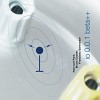
io 0.0.1 beta++ (SLAMCD 531) [details…]
Performers: io 0.0.1 beta++ (itself), Han-earl Park (guitar), Bruce Coates (alto and sopranino saxophones) and Franziska Schroeder (soprano saxophone).
© 2011 Han-earl Park.
℗ 2011 SLAM Productions.

Mathilde 253 (SLAMCD 528) [details…]
Performers: Charles Hayward (drums, percussion and melodica), Han-earl Park (guitar) and Ian Smith (trumpet and flugelhorn) plus Lol Coxhill (saxophone).
© 2010 Han-earl Park.
℗ 2010 SLAM Productions.
updates
10-04-13: add audio excerpts and reviews, plus some small formating changes.
io 0.0.1 beta++: (musical) time and machine musicianship 0.1
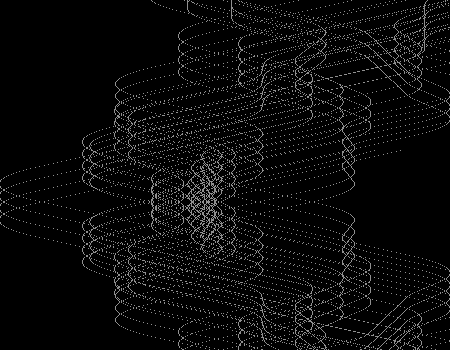
Second part of a series at the io 0.0.1 beta++ website about musical time, rhythm, musicality and politics:
The issue is not so much that a musicality built up from a simple ‘beat detection’ is not possible…. The issue is the implications of seeking and defining, in research, such a trait; valuing such a musicality; and, by extension, practicing such a music.
As argued by Suzanne Cusick, George E. Lewis, Christopher Small and others, musical practice constitutes a political schema—music performs society. The command-control model embedded in a musicality built upon ‘beat detection’ has profound consequences for constructing alternative politics.

The construction of io 0.0.1 beta++ has been made possible by the generous support of the Arts Council of Ireland.
io 0.0.1 beta++: (musical) time and machine musicianship
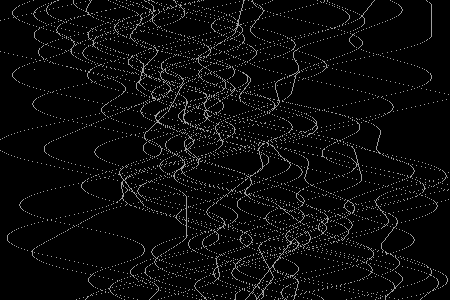
First post as part of a series at the io 0.0.1 beta++ website about musical time, bodies, computation, machine musicianship, and the regulation of the musical:
Perhaps the assumption of a foundational importance to musicality of a simple ‘beat detection’ stems from subscribing to a command-control model of musicality. In this model the mind is the central hub of the musical. In this model, rhythm is constant, inherited, external and which must be followed. This model, in turn, arises from certain, widely held to be sure, cultural assumptions about desirable and ‘natural’ social and political interactions. What do these assumptions blind us from?

The construction of io 0.0.1 beta++ has been made possible by the generous support of the Arts Council of Ireland.
…and more CD reviews: io 0.0.1 beta++
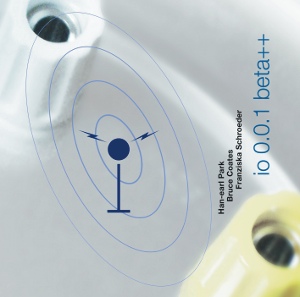
Two more reviews of ‘io 0.0.1 beta++’ (SLAMCD 531) with two contrasting takes on the meeting between human and machine musicians. Ken Waxman, on the one hand, juxtaposes the “unobtrusive and egoless” machine with the human improvisers who display, for example, “thoughtful pauses”:
…Han-earl Park personifying Dr. Frankenstein, has created a non-human artificial musician from ad-hoc components including speakers, kitchenware and missile switches. This CD is a literal record of how the non-human, prosaically named io 0. 0. 1 beta++, sounds in concert with flesh-and-blood counterparts….
io 0. 0. 1 beta++ is unobtrusive and egoless enough… to warble its staccato particle contributions without trying to engulf or show up the humans. Its contributions are unique enough on their own.
For instance on the initial ‘Pioneer: Variance’ and ‘Pioneer: Dance’ contrasting alto and soprano saxophone trills and squeaks are put into bolder relief as the otherworldly flutters, oscillated tones and flanged rotations of the machine are kept in a straight line by Park’s legato picking. The thoughtful pauses audible in the guitar playing confirms Park’s human-ness, especially when compared to the grainy whistles and juddering vibrations that arise from io 0. 0. 1 beta++….
Nonetheless the machine further demonstrates its versatility on the 59-second ‘4G’, with metallic muted trombone-like snores and even raises the question as to whether io 0. 0. 1 beta++ or extended saxophone techniques are creating the air pops and abrasive tongue flutters on subsequent tracks. In the main crackling reductionist resonations are attributed to its properties, while any legato or lyrical intermezzos are, more likely than not, propelled from the instruments and imaginations of full-fledged Homo sapiens.
Succinctly as the three demonstrate on ‘Return Trajectory’, during which io 0. 0. 1 beta++ appears to have taken five, an additional voice—human or otherwise—is necessary to create a pleasing sound picture. The guitarist’s connective down strokes plus the swelling layers of contrapuntal reed timbres are distinctive and solipsistic enough on their own. [Read the rest…]
— Ken Waxman (JazzWord)
Romualdo Del Noce at Jazz Convention, on the other hand, hears a “charmingly imperfect interplay” between human and machine musicians becomes a drama of the ‘human,’ the ‘other,’ and of cyborgs. An interplay in which Han-earl Park improvises a “rugged plateau” and “hyperacid notes”, and Franziska Schroeder enriches “the other half of the sax… with a naked and experimental voice, together in harmony and dissonance with parallel and converging streams of the thoroughbred free-player Bruce Coates”.
Le corde tese di Park imbastiscono un plateau scabro ma di lungo e persistente respiro, vivente nelle articolazioni e nella tessitura della sua fisica elettroacustica; mentre sul versante “meccanico” dell’instrumentarium i modi performanti di Franziska Schroeder arricchiscono l’altra metà del sax (a fianco delle Matana Roberts, Alexandra Grimal, Ingrid Laubrock etc.) di una voce sperimentante e nuda, in sintonia e insieme dissonanza con i flussi paralleli e convergenti del free-player purosangue Bruce Coates, e il tutto si dipana entro uno svolgimento a canovaccio libero e istantaneo, lungo il suo deviante svolgimento interrogandosi (senza eccessivo paradosso) se l’autentica “alienità” sia rispettivamente appannaggio della cosa o, piuttosto e viceversa, dell’ “umano”….
Insomma, l’avanguardia è tornata: non che fosse mai stata davvero latitante, ma gli interrogativi sonori, lacerati e critici, del trio pongono come oggetto radicale la disumanizzazione progressiva e le implicazioni del sempre più preponderante avvento della macchina, forse retrodatando le intenzioni alle prime decadi del secolo scorso e alle relative allarmistiche dottrine, ma riprendendole lungo le forme acutamente nervose e l’attenzione creativa dei medianici e cyborghiani performers e del loro interplay attrattivamente imperfetto. [Read the rest…] [English translation…]
— Romualdo Del Noce (Jazz Convention)
‘io 0.0.1 beta++’ (SLAMCD 531) with Han-earl Park, Bruce Coates and Franziska Schroeder is available from SLAM Productions. [More info…] [All reviews…] [Get the CD…]

The construction of io 0.0.1 beta++ has been made possible by the generous support of the Arts Council of Ireland.
site update: discography
In anticipation of the upcoming release of ‘Numbers’ (CS 201 cd) with Richard Barrett, I’ve updated my discography page. In addition to the usual changes, I’ve now divided the page between physical and download releases, and anthologies.
All artwork and cover graphics copyright their respective owners. ‘Numbers’ (CS 201 cd) CD cover © 2012 Creative Sources Recordings. ‘Live at the Glucksman gallery, Cork’ CD cover © 2009 Jamie Smith/Owlhouse Recordings.
upcoming CD: Numbers: Richard Barrett + Han-earl Park
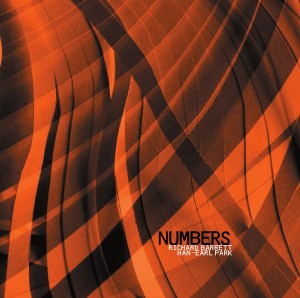
To be released by Creative Sources Recordings in February 2012: ‘Numbers’ (CS 201 cd) with Richard Barrett and Han-earl Park [about this duo…].
[Creative Sources catalog page…]
More info to follow…
Download of the Day at All About Jazz: Paul Dunmall, Han-earl Park and Mark Sanders
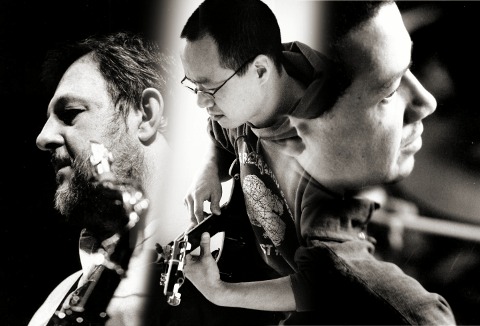
Free jazz, in no uncertain terms. I don’t know what it is about Han-Earl’s groups’ sounds. Ten seconds in, I think to myself, “Man, this isn’t my thing.” But by the time the tune is over, I realize that I’m totally into it and enjoying it. If a musician can convert my ears within the span of one tune, in my eyes, that’s a sign of talent.
All About Jazz features ‘shoapnxoe gutair dmurs a.ii’ by Paul Dunmall, Han-earl Park and Mark Sanders as today’s Download of the Day! I’m again happy and honored to have a recording on AAJ’s download selection (previously featured: ‘Carrier’ with Richard Scott and ‘Chorale’ with Franziska Schroeder). Thanks to AAJ downloads editor Dave Sumner for selecting the recording, to Chris Trent for the recording and mastering work, and to Mike Hurley of Fizzle for hosting the performance at which the recording was made.
[Track at AAJ…] [High-quality download of the full performance…]
